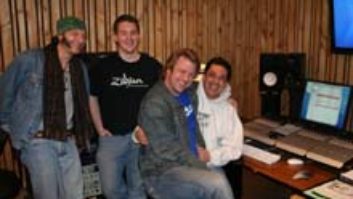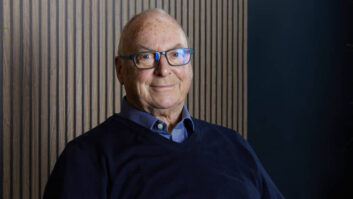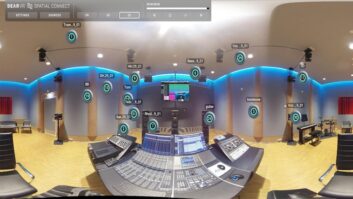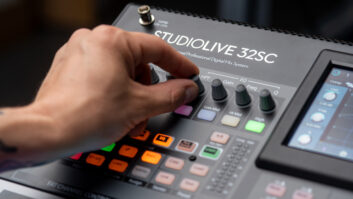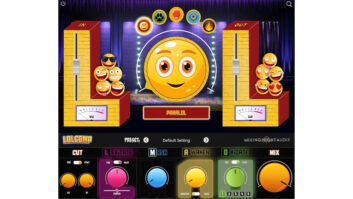Los Angeles, CA—The L.A. Philharmonic, conducted by Gustavo Dudamel, launched its 100th season at the beginning of October with L.A. Fest, “a genre-spanning exploration of the sounds of the city that has inspired it for the last 100 years,” featuring the work of native and transplanted musical artists. The 11-day program at the Walt Disney Concert Hall included an evening with Moby, performing for the first time with an orchestra as he played some of his hits in a set that concluded with surprise special guest: Los Angeles mayor Eric Garcetti on piano.
The concert hall, part of the four-venue Music Center in downtown Los Angeles, installed a DiGiCo SD5 at front-of-house and an SD10 at the monitor position in early 2015. But as Andrew “Drew” Curtis, Moby’s FOH engineer, explains, he and project manager Meegan Holmes worked with Eighth Day Sound to supply a DiGiCo SD12 from its local facility that he could use for both the show and for rehearsals in advance of the world-premiere event with the L.A. Phil.
“We needed something that could handle a rehearsal for the band prior to the show and then, on the same session, to save programming time, [we had to be able to] drop it in at front-of-house next to the hall’s DiGiCo console without having to pull any seats. I’ve used pretty much every console in the DiGiCo line and I do enjoy the SD12’s ratio of power to size,” says Curtis, whose credits at FOH and monitors during 14 years of touring includes Seal, OK Go, Tycho, Kesha and others. He also owns and operates Telesonix, an L.A.-based wireless microphone and IEM equipment rental and RF coordination company.
Following a prep day with Eighth Day Sound technician Dane Tarmann, Curtis continues, he headed to the rehearsal room, where the desk did double duty: “I was able to build a session that was functional on the monitor side and the front-of-house side simultaneously. Part of the reason to choose the SD12 was its flexibility and the fader count, which made the monitor part of the rehearsal quite a bit easier.”
He continues, “What draws me to that desk is being able to get an accurate representation of what’s happening; it’s such a neutral platform. I love the dynamic EQ on the desk, and I use the Digitube mic preamp section on the vocals generally, just to create a little bit of interesting harmonic content.”
Related: DiGiCo Desks Debut at Disney, March 12, 2015
On the night of the show, Curtis adds, “I took care of all the band inputs that we rehearsed with prior—roughly 24 inputs, including the drum kit, a bass guitar, a solo cello, Moby’s piano and acoustic guitars, and all of the wireless vocals. There were three lead vocalists who split the duties on their respective songs for that particular set: Mindy Jones, Julie Mintz and Apollo Jane.”

Curtis worked alongside Shawn Murphy, who managed 72 inputs from the L.A. Philharmonic and a gospel choir, the Jason White Singers, on the hall’s SD5. “My approach was to leave as much room for Shawn as possible,” says Curtis, “so I took a conservative approach to the room. Once we had the orchestra in for the full rehearsal on the day of the show, I was able to have a chat with Shawn and ensure we were on the same page as far as SPL and the venue’s expectations.”
Murphy is a studio and live sound engineer who is probably best known for his film score mixing work, with more than 350 movie credits and an Academy Award, for 1993’s Jurassic Park, to his name. Although he says he’s relatively new to the SD5, he has had a lot of experience with the SD7 at the Hollywood Bowl and with the Chicago Symphony and Pacific Symphony, as well as the SD10.
Amplifying the orchestra was a deliberate choice, says Murphy. “Given the fact that Moby’s vocal, his solo instruments and his band were going to be somewhat amplified, and given the constraints of the concert hall acoustics, they felt that the orchestra needed to be helped—certain sections especially, such as the strings and winds—as invisibly as possible within the context of the amplified group.”
He adds, “We modified the [in-house] Meyer Sound reinforcement system a little bit to accomplish that and changed the miking to emphasize that approach. I had them acquire an additional 20 DPA 4099s, which I used on stands,” a method he frequently employs. “Assuming the show is not too loud, the sound is very good. The leakage is under control because they are hypercardioids, and they’re invisible.”
Overall, says Murphy, “I think it came off very well. Sonically, we played it a little bit louder than I thought we would, but no one objected.”
Related: Kraftwerk’s Catalog of Concerts, by Steve Harvey, May 21, 2014
At the SD10, monitor engineer Kevin Wapner, the hall’s head of audio, fed stereo mixes to the band’s Shure PSM 1000 packs. “They were all pretty precise about where they wanted things panned and placed—pretty much the way they were looking at the stage and heard the orchestra,” he says.
For the orchestra, “The L.A. Phil percussion players were also on in-ears. And I put out a few hotspot speakers, with one for the conductor,” says Wapner.
Curtis miked Moby and the band using a mix of DPA and Shure capsules atop Lectrosonics RF handheld transmitters from the hall’s inventory. “I used a DPA d:facto 4018 capsule on Moby’s voice, which I’ve really enjoyed lately,” he says. “Two of the female vocalists are super soft-spoken; knowing the gain-before-feedback capabilities of the Shure Beta 58, I opted for that.”
Want more stories like this? Subscribe to our newsletter and get it delivered right to your inbox.
Curtis miked the kick drum with a Shure Beta 91A inside and an SM7 outside. “I can get a different and super interesting sound that I can blend, depending on the song,” he says. An SM57 covered the snare top, with a Beyer M201 on the bottom.
During rehearsals, Curtis had used a Royer R-122 active ribbon to capture the punch of the toms without grabbing too much cymbal high-end. “We ended up going without toms, but I still liked the darker, natural tone of the ribbons on the whole kit,” he says. A Neve RNDI on the bass and a Radial JDI on Moby’s acoustic guitar, plus DPA 4099s on the solo cello and the piano, rounded out the band mic plan.
While the Moby show received a lot of attention from fans of both the artist and the L.A. Phil, it garnered just a quarter of Murphy’s attention simply for the fact that it was one of four consecutive events at the hall for him. By the end of the run, he had mixed the L.A. Phil with singer/songwriter and violinist Andrew Bird the day before Moby and with Herbie Hancock the day after, and then he closed out L.A. Fest with a unique Pan-American event featuring La Santa Cecilia and Cuco.
L.A. Philharmonic, www.laphil.com
DiGiCo, www.digico.biz
